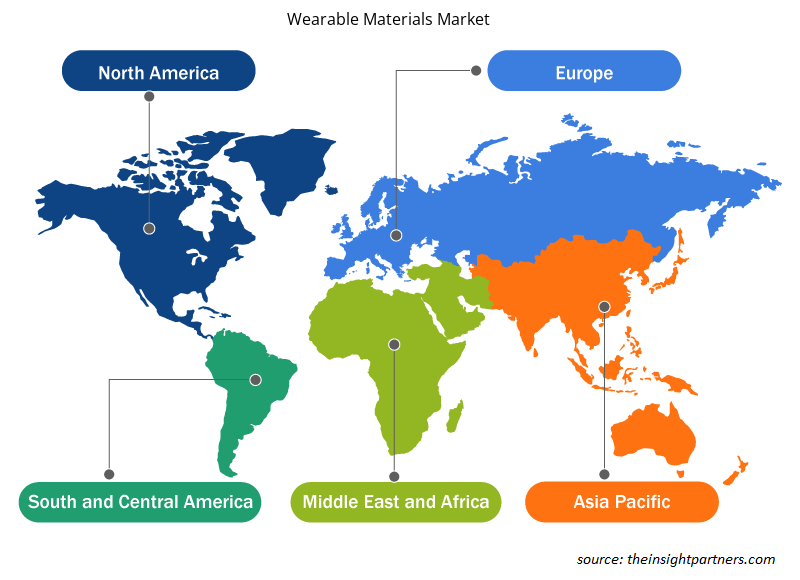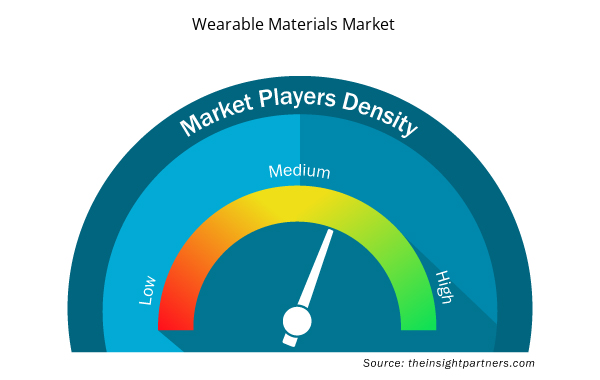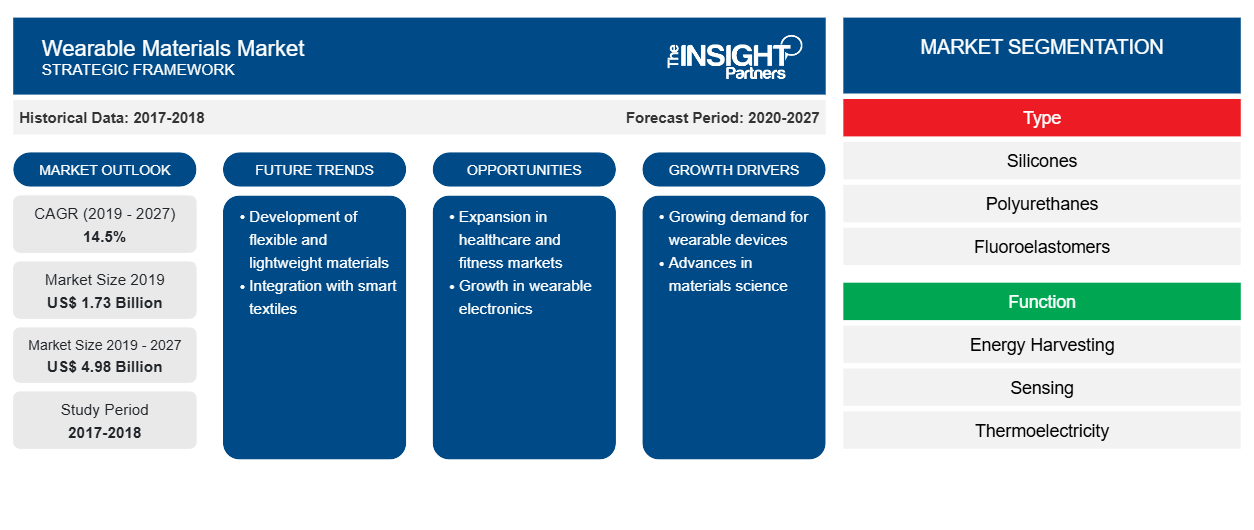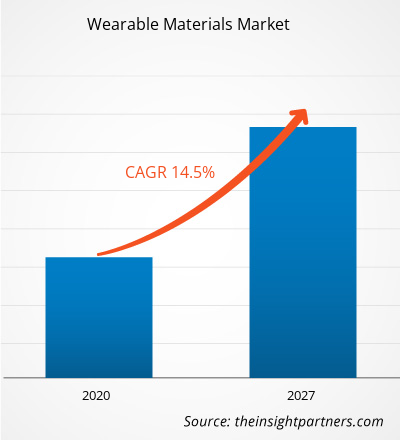Insight Partners 表示, 2019 年可穿戴材料市场价值为 17.3267 亿美元,预计2020 年至 2027 年的复合年增长率为 14.5%
可穿戴材料可灵活用于生产可穿戴设备及其部件,如传感器和电池。这些材料具有独特的特性,包括渗透性、透明度、粘附性和加工性,以及生物相容性。此外,它们对皮肤非常友好。可穿戴技术的普及带来了对材料的巨大需求,这些材料可以承受日常使用带来的磨损。此外,这类材料重量相对较轻,穿着舒适灵活,因此在各种应用领域都有应用。这类材料用于生产健身带、智能手表、健身追踪器和医疗设备,以测量实际身体状况。
2019 年,亚太地区是可穿戴材料的最大市场。该地区最大的市场份额主要归因于亚太地区发达经济体和发展中经济体可穿戴材料的生产和消费增长。中国被认为是可穿戴材料需求和产量显著增加的最大市场之一。其他遵循可穿戴材料市场增长模式的经济体包括日本、印度和韩国。由于快速的城市化、对技术先进产品的日益倾向以及可支配收入的增加等因素,亚太地区对可穿戴材料市场的增长做出了重大贡献。除此之外,该地区主要制造商的存在也极大地推动了该地区可穿戴材料市场的增长。
2019 年 12 月,COVID-19 疫情首先在中国武汉爆发,此后迅速蔓延至全球。截至 2020 年 9 月,美国、印度、巴西、俄罗斯、南非、墨西哥和英国是确诊病例和死亡人数最多的国家。由于封锁、旅行禁令和企业停业,COVID-19 疫情已影响到各国的经济和行业。化工和材料行业是受疫情影响最大的行业之一,因疫情导致办公室和工厂停工、供应链中断等严重中断。
定制此报告以满足您的需求
您可以免费定制任何报告,包括本报告的部分内容、国家级分析、Excel 数据包,以及为初创企业和大学提供优惠和折扣
- 获取此报告的关键市场趋势。这个免费样品将包括数据分析,从市场趋势到估计和预测。
市场洞察
可穿戴和便携式电子设备需求不断增长
随着数字化和技术的快速创新,健身追踪器、健身带和智能手表等新型可穿戴设备不断推出,可以追踪佩戴者的运动、心率等。许多健身公司已经开始生产智能跑步袜,可以追踪佩戴者的跑步数据,如速度、时间和距离。大多数可穿戴材料由硅胶等织物制成,这些织物耐用、透气,并具有其他特性,如更好的粘附性、渗透性和透明度。公司现在专注于设计可穿戴电子产品和智能织物的印刷材料,以满足成本和多功能性。Fitbit 腕带等多种设备由无乳胶弹性体材料制成,这种材料制成,既灵活又轻便。许多公司和研究人员正致力于开发能够更好地导电并由柔韧透气的材料制成的智能服装。这些衣服采用特殊的静电纺丝工艺生产,该工艺将聚合物纤维与液态的小银线聚集在一起,然后进行过滤、干燥和加热。这些材料还可以承受日常使用的磨损。因此,很明显,随着可穿戴设备需求的激增以及新产品和先进产品的推出,对可穿戴材料的需求将不断增加。
类型洞察
根据类型,可穿戴材料市场分为有机硅、聚氨酯、氟橡胶等。2019 年,有机硅在全球可穿戴材料市场中占有最大份额。有机硅是一种用途广泛的材料,以其渗透性、粘附性、剥离性、透明度和生物相容性而闻名。有机硅被认为是无细胞毒性的。它们对皮肤非常友好,界面结合力低,流动性更强,可实现稳定粘附。这些材料可以根据特定要求进行修改,因此被认为是用于皮肤护理应用的理想材料。此外,与其他有机聚合物相比,有机硅透气性更好,佩戴更舒适。此类材料越来越多地用于生产可穿戴医疗和消费电子设备。这些因素进一步推动了全球可穿戴材料市场的增长。
功能洞察
根据功能,可穿戴材料市场细分为能量收集、传感、热电、发光、加热和冷却等。传感部分在 2019 年占据可穿戴材料市场的最高市场份额。可穿戴设备有多种形式;有智能腕带、手表、衬衫、鞋子、头带、眼镜和项链。它们中的大多数都包含传感器,用于收集原始数据,然后将其输入数据库或软件应用程序进行分析。随着可穿戴设备市场的增长,对传感器的需求显着增加。
应用程序洞察
根据应用,可穿戴材料市场细分为消费电子、医疗、工业和其他。消费电子领域在 2019 年占据可穿戴材料市场的最高市场份额。消费电子是可穿戴材料最广泛的应用。可穿戴消费电子产品包括与健身和运动、娱乐和多媒体以及服装和时尚相关的多种可穿戴设备。消费者需求不断增长和传感器技术快速小型化等因素促进了可穿戴市场的增长,进而增加了对可穿戴材料的需求。
阿科玛、迈图、路博润、瓦克化学、科思创、帝斯曼、索尔维、信义、巴斯夫和杜邦是全球可穿戴材料市场的主要参与者。可穿戴材料市场的主要参与者专注于并购和研发等战略,以增加全球地域影响力和消费者基础。
可穿戴材料市场区域洞察
Insight Partners 的分析师已详尽解释了预测期内影响可穿戴材料市场的区域趋势和因素。本节还讨论了北美、欧洲、亚太地区、中东和非洲以及南美和中美洲的可穿戴材料市场细分和地理位置。

- 获取可穿戴材料市场的区域特定数据
可穿戴材料市场报告范围
| 报告属性 | 细节 |
|---|---|
| 2019 年市场规模 | 17.3亿美元 |
| 2027 年市场规模 | 49.8亿美元 |
| 全球复合年增长率(2019 - 2027) | 14.5% |
| 史料 | 2017-2018 |
| 预测期 | 2020-2027 |
| 涵盖的领域 | 按类型
|
| 覆盖地区和国家 | 北美
|
| 市场领导者和主要公司简介 |
|
市场参与者密度:了解其对商业动态的影响
可穿戴材料市场正在快速增长,这得益于终端用户需求的不断增长,而这些需求又源于消费者偏好的不断变化、技术进步以及对产品优势的认识不断提高等因素。随着需求的增加,企业正在扩大其产品范围,进行创新以满足消费者的需求,并利用新兴趋势,从而进一步推动市场增长。
市场参与者密度是指在特定市场或行业内运营的企业或公司的分布情况。它表明在给定市场空间中,相对于其规模或总市场价值,有多少竞争对手(市场参与者)存在。
在可穿戴材料市场运营的主要公司有:
- 阿科玛
- 巴斯夫
- 科思创公司
- 帝斯曼
- 杜邦公司
免责声明:上面列出的公司没有按照任何特定顺序排列。

- 了解可穿戴材料市场顶级关键参与者概况
全球可穿戴材料市场(按类型)
- 有机硅
- 聚氨酯
- 氟弹性体
- 其他的
全球可穿戴材料市场按功能划分
- 能量收集
- 传感
- 热电
- 发光
- 加热和冷却
- 其他的
全球可穿戴材料市场(按应用划分)
- 消费电子产品
- 医疗的
- 工业的
- 其他的
公司简介
- 阿科玛
- 迈图
- 路博润公司
- 瓦克化学股份有限公司
- 科思创公司
- 帝斯曼
- 索尔维公司
- 信越化学工业株式会社
- 巴斯夫
- 杜邦公司
- 历史分析(2 年)、基准年、预测(7 年)及复合年增长率
- PEST 和 SWOT 分析
- 市场规模价值/数量 - 全球、区域、国家
- 行业和竞争格局
- Excel 数据集



Report Coverage
Revenue forecast, Company Analysis, Industry landscape, Growth factors, and Trends

Segment Covered
This text is related
to segments covered.

Regional Scope
North America, Europe, Asia Pacific, Middle East & Africa, South & Central America

Country Scope
This text is related
to country scope.
常见问题
The growth of the silicone segment is primarily attributed to its unique properties such as permeability, adhesion, peeling, transparency, and biocompatibility properties. Silicones are considered non-cytotoxic and are quite skin friendly with low interfacial bonding and greater flowability for stable adhesion. These materials can be modified according to specific requirements and are, therefore, considered as ideal materials to be used in skin care applications.
The major players operating in the global wearable material market are Arkema, Momentive, The Lubrizol Corporation, Wacker Chemie AG, Covestro AG, DSM, Solvay S.A, Shin-Itsu, BASF SE and Dupont, among others.
In 2018,the wearable material marketwas predominantinAsia Pacificat theglobal level.Rapid urbanization coupled with increase in disposable income and shift in consumer lifestyle are some of the potential drivers facilitating the growth of the wearable material market in the Asia Pacific. Further, the growth of end use industries such as medical and healthcare, automotive, electrical and electronics, and other along with strong presence of leading manufacturers have significantly driven the growth of the wearable material market in the region.
Trends and growth analysis reports related to Chemicals and Materials : READ MORE..
The List of Companies - Wearable Material Market
- Arkema
- BASF SE
- Covestro AG
- DSM
- DuPont de Nemours, Inc.
- Momentive
- Shin-Etsu Chemical Co., Ltd.
- Solvay S.A.
- The Lubrizol Corporation
- Wacker Chemie AG
The Insight Partners performs research in 4 major stages: Data Collection & Secondary Research, Primary Research, Data Analysis and Data Triangulation & Final Review.
- Data Collection and Secondary Research:
As a market research and consulting firm operating from a decade, we have published and advised several client across the globe. First step for any study will start with an assessment of currently available data and insights from existing reports. Further, historical and current market information is collected from Investor Presentations, Annual Reports, SEC Filings, etc., and other information related to company’s performance and market positioning are gathered from Paid Databases (Factiva, Hoovers, and Reuters) and various other publications available in public domain.
Several associations trade associates, technical forums, institutes, societies and organization are accessed to gain technical as well as market related insights through their publications such as research papers, blogs and press releases related to the studies are referred to get cues about the market. Further, white papers, journals, magazines, and other news articles published in last 3 years are scrutinized and analyzed to understand the current market trends.
- Primary Research:
The primarily interview analysis comprise of data obtained from industry participants interview and answers to survey questions gathered by in-house primary team.
For primary research, interviews are conducted with industry experts/CEOs/Marketing Managers/VPs/Subject Matter Experts from both demand and supply side to get a 360-degree view of the market. The primary team conducts several interviews based on the complexity of the markets to understand the various market trends and dynamics which makes research more credible and precise.
A typical research interview fulfils the following functions:
- Provides first-hand information on the market size, market trends, growth trends, competitive landscape, and outlook
- Validates and strengthens in-house secondary research findings
- Develops the analysis team’s expertise and market understanding
Primary research involves email interactions and telephone interviews for each market, category, segment, and sub-segment across geographies. The participants who typically take part in such a process include, but are not limited to:
- Industry participants: VPs, business development managers, market intelligence managers and national sales managers
- Outside experts: Valuation experts, research analysts and key opinion leaders specializing in the electronics and semiconductor industry.
Below is the breakup of our primary respondents by company, designation, and region:

Once we receive the confirmation from primary research sources or primary respondents, we finalize the base year market estimation and forecast the data as per the macroeconomic and microeconomic factors assessed during data collection.
- Data Analysis:
Once data is validated through both secondary as well as primary respondents, we finalize the market estimations by hypothesis formulation and factor analysis at regional and country level.
- Macro-Economic Factor Analysis:
We analyse macroeconomic indicators such the gross domestic product (GDP), increase in the demand for goods and services across industries, technological advancement, regional economic growth, governmental policies, the influence of COVID-19, PEST analysis, and other aspects. This analysis aids in setting benchmarks for various nations/regions and approximating market splits. Additionally, the general trend of the aforementioned components aid in determining the market's development possibilities.
- Country Level Data:
Various factors that are especially aligned to the country are taken into account to determine the market size for a certain area and country, including the presence of vendors, such as headquarters and offices, the country's GDP, demand patterns, and industry growth. To comprehend the market dynamics for the nation, a number of growth variables, inhibitors, application areas, and current market trends are researched. The aforementioned elements aid in determining the country's overall market's growth potential.
- Company Profile:
The “Table of Contents” is formulated by listing and analyzing more than 25 - 30 companies operating in the market ecosystem across geographies. However, we profile only 10 companies as a standard practice in our syndicate reports. These 10 companies comprise leading, emerging, and regional players. Nonetheless, our analysis is not restricted to the 10 listed companies, we also analyze other companies present in the market to develop a holistic view and understand the prevailing trends. The “Company Profiles” section in the report covers key facts, business description, products & services, financial information, SWOT analysis, and key developments. The financial information presented is extracted from the annual reports and official documents of the publicly listed companies. Upon collecting the information for the sections of respective companies, we verify them via various primary sources and then compile the data in respective company profiles. The company level information helps us in deriving the base number as well as in forecasting the market size.
- Developing Base Number:
Aggregation of sales statistics (2020-2022) and macro-economic factor, and other secondary and primary research insights are utilized to arrive at base number and related market shares for 2022. The data gaps are identified in this step and relevant market data is analyzed, collected from paid primary interviews or databases. On finalizing the base year market size, forecasts are developed on the basis of macro-economic, industry and market growth factors and company level analysis.
- Data Triangulation and Final Review:
The market findings and base year market size calculations are validated from supply as well as demand side. Demand side validations are based on macro-economic factor analysis and benchmarks for respective regions and countries. In case of supply side validations, revenues of major companies are estimated (in case not available) based on industry benchmark, approximate number of employees, product portfolio, and primary interviews revenues are gathered. Further revenue from target product/service segment is assessed to avoid overshooting of market statistics. In case of heavy deviations between supply and demand side values, all thes steps are repeated to achieve synchronization.
We follow an iterative model, wherein we share our research findings with Subject Matter Experts (SME’s) and Key Opinion Leaders (KOLs) until consensus view of the market is not formulated – this model negates any drastic deviation in the opinions of experts. Only validated and universally acceptable research findings are quoted in our reports.
We have important check points that we use to validate our research findings – which we call – data triangulation, where we validate the information, we generate from secondary sources with primary interviews and then we re-validate with our internal data bases and Subject matter experts. This comprehensive model enables us to deliver high quality, reliable data in shortest possible time.


 获取此报告的免费样本
获取此报告的免费样本